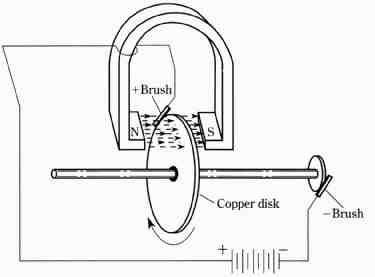AMAZON multi-meters discounts AMAZON oscilloscope discounts
.The arrangement shown in FIG. 18 implements the principle used in the first practical electric motor and generator. At first inspection, the terms homopolar or unipolar appear to be misnomers. Two magnetic poles are, indeed, present, and any allusion to the elusive magnetic monopole was surely not intended by the originators of these names. (The machines are also referred to as acyclic types.) The basic operational difference from conventional motors and generators is that the active conductor interacts with the magnetic field only once per revolution. Note that whichever segment of the disk happens to be within the field is inherently the active conductor. In conventional machines of even the simplest type, a given armature conductor interacts with the field twice per revolution, and in so doing, it either generates or requires an alternating current. In contrast, the homopolar is a true dc ma chine. It needs no commutator to convert dc to ac, or vice versa.

FIG. 18 The homopolar machine devised by Michael Faraday.
This method of developing motor and generator action is often thought of as a primitive stepping stone to techniques representing greater technical sophistication. However, the homopolar machine represents a very practical approach for certain applications, and has been built in sizes ranging up to several thousand kilowatts. It is basically a high-current low-voltage machine, but higher voltages have been handled by extending the construction to accommodate multiple disks. This machine is destined to enjoy revived consideration because modern material technology, de vices, and techniques make it again amenable to a hope that has never died—the elimination of the commutator. Current is conducted to and from the disk by slip-ring techniques. This has proved an obstacle in high-current applications; however, many designers would rather contend with this problem than that of clean and reliable commutation.
To illustrate what is implied by “modem methods,” consider the following: homopolar motors and generators have been made in the several-hundred to several thousand horsepower range and make use of superconducting field windings. Such field excitation involves fluxes of 60,000 gauss, and even stronger fields will be feasible. A shipboard propulsion motor of this type tends to be about one half the physical size of ordinary motors, In one design, contact to the disk is made by means of a liquid metallic alloy that has more than twenty-five times the current-carrying capacity of brushes. The success thus far indicated suggests the increase of capacity to the 30,000- horsepower level. When combined with solid-state control techniques, these grown-up Faraday disks can be expected to become competitive, rather than archaic.